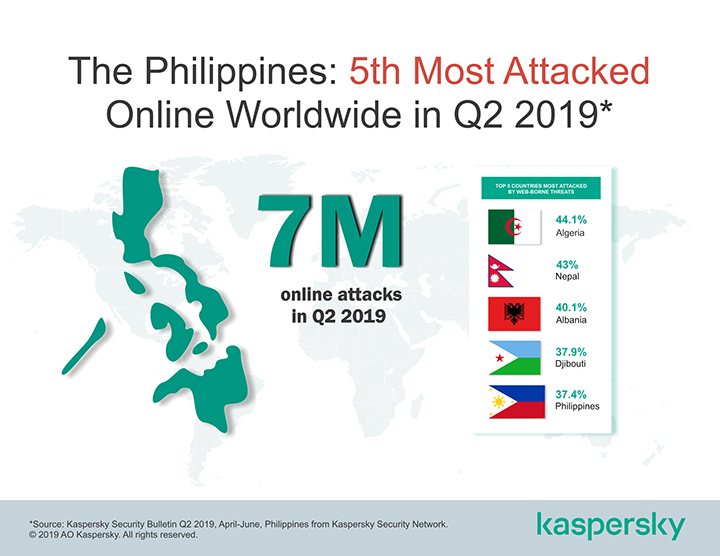The Philippines now ranks fifth in Kaspersky’s global ranking of countries with the highest number of detected Internet-borne attacks. In its Global Q2 2019 Security Bulletin, data from the Kaspersky Security Network (KSN) showed nearly seven million or 37.4% of Kaspersky users in the Philippines were attempted to be attacked by threats while surfing the web from April to May this year. With the newly-recorded figures, the country went a few notches up from last year’s ranking of ninth overall with 10.7 million Internet-borne malware incidents monitored and blocked by Kaspersky products.
The Philippines rounds off the top five in the cybersecurity company’s global list, namely: Algeria (44.1%), Nepal (43%), Albania (40.1%), and Djibouti (37.9%).
The statistics in the report are based on completely anonymous data obtained from Kaspersky products installed on users’ computers in the Philippines. The KSN generates reports for countries with more than 10,000 Kaspersky users each.
How Filipino Internet users are commonly attacked on the web
Data from Kaspersky revealed that its users in the Philippines were still tried to be attacked by cybercriminals through the popular attack method called drive-by download.
Attempts to infect users’ computers and devices normally happen when a web surfer visits a website that he/she didn’t know was infected. Such an insecure website is planted with malicious scripts that install malware directly onto the computer or device.
A drive-by download attack requires no action on the part of the Internet user. Once in an infected website, the user’s computer or device gets infected automatically, and silently, particularly if the computer is vulnerable in some way, such as when its operating system, any of its applications, or its web browser contain security flaws due to unsuccessful updates or lack of updates.
Another technique that cybercriminals use to attempt to attack computers and devices of Philippine-based Kaspersky users is social engineering. In this method, cybercriminals convince an unsuspecting user into sending to them their confidential data, infecting their computers with malware or opening links to infected websites.
Hackers also try to take advantage of a user’s lack of knowledge by persuading them to disclose only a few pieces of information such as name, date of birth or address to gain access to multiple networks by pretending to be friends or families or even as IT support personnel.
Malicious hosts slightly up, local threats down

In the same report though, Kaspersky also noted a minor increase in cyberthreat incidents caused by servers hosted in the Philippines. About 67,000 or 15% more incidents were recorded from April-June this year compared to the same quarter in 2018. These figures placed the Philippines at 34th this year from 36th in 2018.
Meanwhile, Kaspersky products detected and blocked about 13 million local incidents on computers of Filipino users in this period, positioning the Philippines in the 65th spot worldwide compared to its 59th ranking in April to May last year.
Local threats or incidents are those that are caused by malware spread via removable media such as USB drives, CDs and DVDs, and other “offline” methods.
“Despite a few hitches here and there, Filipinos continue to enjoy the freedom of being able to access the Internet from any device. With a single click, a user can go anywhere in the cyberworld. It’s just effortless. The targeted Kaspersky users is about nine percent of the total Internet users in the Philippines today which, from a cybersecurity point of view, is a big number and is worth paying attention to,” said Yeo Siang Tiong, General Manager for Kaspersky Southeast Asia.
“We can still point at the general carelessness and lack of online security awareness among our Filipino Internet users. Like it is a known fact that when one buys a new smartphone, he or she will buy a protective case or some accessories, but not an internet security solution. On social media alone, the 18-34 years old age bracket account for 63% of users this year compared to only 41.7% in 2018. And with recent data that says each Internet user now owns an average of 10 social media accounts, we need to be resolute in our push to have every person using the Internet to learn how to actively safeguard his or her data,” Yeo added.
To help avoid rogue programs to be downloaded onto your computer or mobile device, here are seven useful tips from Kaspersky researchers:
- Eliminate vulnerabilities by keeping your OS and apps updated. Remember to include web browsers, Flash player and PDF reader, too.
- Keep your Internet security software up to date. It’s a good idea to enable the “receive automatic updates” option within your security product.
- Be cautious about search engine results. Avoid clicking on sponsored links within Internet search results.
- Type the URL into the address bar. It may take a little more time but can be a lot safer.
- Beware of web surfing dangers. Avoid accessing and exploring unknown websites.
- Don’t open unexpected attachments. If you need to do so, verify that it’s genuine and scan to make sure it doesn’t contain any malware.
- Think about that link before you click it. Better not click on random links in emails, instant messaging or social networking sites.


